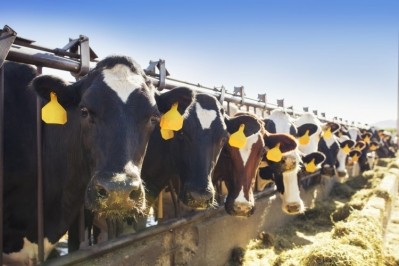Inside Danone’s methane strategy: ‘This is the most immediate opportunity we have to slow global warming’

Methane is amongst the most potent of the greenhouse gases, second only to CO2 in contributing to global warming in recent history. Agriculture and livestock activities are a major contributor, with dairy production from cattle making up an estimated 8% of total human-caused methane emissions.
Since the Global Methane Pledge was backed by the EU, meaning it plans to cut methane emissions by 30% by 2030, dairy producers have been under pressure to reduce CH4 output.
This includes Danone, which wants to achieve methane reduction ambitions without limiting dairy production. “Cutting methane emissions is the most immediate opportunity we have to slow down global warning, and we believe dairy farming can be a part of the solution,” a company spokesperson told FoodNavigator.
Do consumers want low methane dairy?
Danone is committed to cutting back on methane emissions. Last year, the dairy major announced plans to reduce absolute methane emissions from its fresh milk supply chain by 30% by 2030 – equating to 1.2m tons CO2eq.
But unlike many strategies set by FMCG majors, this one does not appear to be consumer-led.
That is not to say that environmental sustainability is not important to shoppers. It is. According to Nielsen and Mintel data, 70% of consumers globally claim sustainability is now more important to them than it was two years ago, and 49% have made changes to their diets to support a more sustainability lifestyle.
But as to whether consumers specifically want lower methane products is doubtful, given that current understanding is low. “Climate change, methane reduction and regenerative agriculture can be complex and technical topics, and we know consumers currently have a limited understanding of how their food choices relate to them,” explained the Danone spokesperson.
The dairy major believes it has a role to play in helping to demystify these topics and bring consumers along on the journey as it ‘supports the transition to regenerative agricultural practices’.
How is Danone reducing methane emissions from dairy?
The question remains: how is Danone working to cut methane emissions by 30% - against a 2020 baseline – within the next six years?
To begin with, it needs to work with its network of 58,000 farmers across 20 countries to get there. The company accelerated methane reduction initiatives in Africa, Europe and the US last year, and has ramped up regenerative agriculture projects that aim to reduce overall greenhouse gas (GHG) emissions – including methane.
Other levers are also being pulled, including focus on animal health and herd management; feed management; manure management; and applying new technologies that serve to inhibit methane production, for example feed additives and cow-wearables.
Developed by the Zero Emissions Livestock Project (ZELP), the wearable tech aims to neutralise methane emissions from cattle burps.
On the feed additive side of things, Danone has been working with DSM-Firmenich’s Bovaer. The additive works by suppressing methane production in the cow’s stomach. Made from two ingredients – nitrate and bio-based alcohol – the feed is naturally broken down and processed by the animal’s metabolism, without affecting production volumes or milk quality.
“Our feed management pilot in Belgium has shown promising results when using Bovaer . . . that demonstrated an 18.3% reduction in enteric methane emissions,” said the spokesperson.
Late last year, Danone became the first corporation to join the Global Methane Hub’s Enteric Fermentation R&D Accelerator, which aims to create new scalable and practical solutions for dairy farmers to reduce methane emissions.
Danone aligns with external partners to accelerate sector progress
In other ways, the dairy major is also engaging in external partnerships to accelerate methane reduction across the sector. Last year, the company announced a strategic partnership with the Environmental Defense Fund to improve science, data and reporting for agricultural methane emissions.
Danone also co-founded the Dairy Methane Action Alliance with the aim of collaborating with other dairy players to collectively tackle the climate change challenges.
Educating consumers about sustainable dairy
While all this work goes on in the background, how can brands best educate consumers about sustainable practices in dairy production? It’s not easy, particularly amid a cost-of-living crisis when shoppers may opt for economical – rather than eco-friendly – products.
At the same time, brands only have a certain amount of space on-pack with which to share information with consumers. On a yoghurt pot, for example, once ingredients lists and nutritional information is printed, there isn’t much space left for details on agricultural practices they can’t be sure consumers will understand.
This may be what Danone has found in France, where it is communicating environmental benefits associated with its Les Deux Vaches brand off-pack. Although not strictly focused on methane production, Les Deux Vaches is helping farmers in the transition towards organic farming through a project coined ‘Reine Mathilde’ (a nod to the Duchess of Normandy, where the organic production development programme is located).
“Les Deux Vaches supports farmers to convert to organic dairy farming practices…and communicates actively about biodiversity and organic dairy farming through social media and its website,” we were told.
As to if and how Danone plans to communicate methane reduction efforts on pack, we’ll have to wait and see. What is certain, is that progress towards the company’s methane goals is underway.
“As the first food company to take this step and align with the ambition of the Global Methane Pledge launched at COP26, this plan builds on our existing work with farmers and partners which has succeeded in reducing methane emissions by 14% between 2018 and 2020.
“Between 2020 and 2023, we have achieved a 13.3% reduction in our methane emissions for fresh milk supply.”













